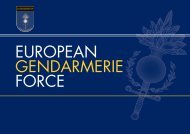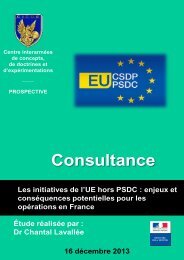Conference
science-research-bulletin-2013-conference
science-research-bulletin-2013-conference
You also want an ePaper? Increase the reach of your titles
YUMPU automatically turns print PDFs into web optimized ePapers that Google loves.
EUROPEAN POLICE SCIENCE AND RESEARCH BULLETIN<br />
SPECIAL CONFERENCE EDITION<br />
LACK OF RIGOUR IN INVESTIGATIONS<br />
Independent investigation does not always<br />
mean a rigorous investigation. In respect of<br />
serious criminal allegations, for example, it<br />
would appear that the police officer or officers<br />
concerned are not subjected to the same robust<br />
arrest, detention and interrogation methods that<br />
would apply typically to civilian counterparts.<br />
Instead the standard practice appears to be to<br />
take a statement from the officer, usually by<br />
appointment. One of the three causes of distrust<br />
in the complaints system identified by the HAC<br />
was that the police often do not interview officers<br />
after cases involving death and serious injury,<br />
although they would routinely do so for ordinary<br />
members of the public (HAC, 2013, para.13). In<br />
its interim report on the Hillsborough disaster, it<br />
found that police officers are rarely interviewed<br />
under caution in circumstances in which an<br />
ordinary member of the public would be (HAC,<br />
2012). In its 2013 report, it stated:<br />
‘The issue of interviewing officers in cases<br />
involving death and serious injury is indicative<br />
of a culture of treating officers differently from<br />
members of the public. Where officers are not<br />
interviewed promptly under caution, this can<br />
lead to weaker evidence and loss of confidence in<br />
the process of investigating serious matters such<br />
as deaths in custody.’ (HAC, 2013, para.85)<br />
It went on to recommend, inter alia, that officers<br />
should be ‘routinely interviewed under caution<br />
in the most serious cases, exactly as a member of<br />
the public would be.’ (HAC, 2013, para.85)<br />
Savage’s research on the procedures in three<br />
of the jurisdictions also found evidence that<br />
the influence of former police investigators was<br />
undermining the rigour and independence of<br />
the procedure. They had a propensity to close<br />
investigations too quickly and to take a narrow<br />
criminal investigation approach, rather than a<br />
broader contextual approach which is open to<br />
the issues raised (Savage, 2013b). They were<br />
not inclined to challenge police narratives. One<br />
telling example cited in the research is where a<br />
former police officer investigator was happy to<br />
accept CCTV evidence provided by the police,<br />
while a fellow investigator from a non-police<br />
background wanted to check local businesses<br />
independently to see if there was video evidence<br />
that the police had not discovered or that they<br />
were concealing (Savage, 2013b). His fears may<br />
have been well founded as the GSOC has felt<br />
compelled recently to criticise the Garda publicly<br />
for impeding its investigations by suppressing<br />
relevant evidence and denying the existence<br />
of statements given by gardai who had taken<br />
part in the policing of a student protest that<br />
had generated numerous complaints (GSOC,<br />
2013b). In its inquiry into IPCC investigations,<br />
the HAC also heard extensive criticisms of, inter<br />
alia: a failure by investigators to locate evidence;<br />
a propensity to accept police explanations for<br />
missing evidence; failure to analyse competing<br />
accounts, even with inconsistencies between<br />
officers’ accounts or a compelling account from<br />
a complainant; a lack of investigative rigour; and<br />
delay (HAC, 2013, para.11).<br />
REGULATORY CAPTURE<br />
Regulatory capture is an established and common<br />
phenomenon in the relationship between a<br />
regulatory agency and the body or bodies being<br />
regulated (Ayre & Braithwaite, 1991). It can arise<br />
on at least two levels. Typically, it emerges and<br />
develops over time as the agency and body<br />
become more familiar with each other’s methods<br />
and practices. As agency personnel engage<br />
exclusively with the work of the persons they<br />
are regulating, there is a tendency to acquire<br />
the perspectives and even the language of those<br />
persons. This is especially so where the persons<br />
being regulated are experienced and hardened<br />
professionals in a specialist field and the<br />
regulators are ‘outsiders’ who have not acquired<br />
that direct experience. In this environment, the<br />
persons being regulated are in a strong position<br />
not just to evade the efforts of the regulators to<br />
control them or call them to account, but also<br />
to steer those efforts in ways and directions that<br />
will serve their interests, usually at the expense<br />
of the regulatory objectives. At another level,<br />
the regulated body might ‘capture’ the regulator<br />
at the outset by shaping its form, function and<br />
powers and/or by negotiating how it will perform<br />
its function.<br />
Arguably, the police complaints systems in<br />
Britain and Ireland have always been the subject<br />
of regulatory capture at both levels from their<br />
inception and right through the successive<br />
waves of reforms. Even today, with the fully<br />
‘independent’ models there is evidence that<br />
their efficacy continues to be undermined<br />
by regulatory capture at both levels. This is<br />
reflected in a tendency for investigators to be<br />
unnecessarily deferential to the police. Savage<br />
54





